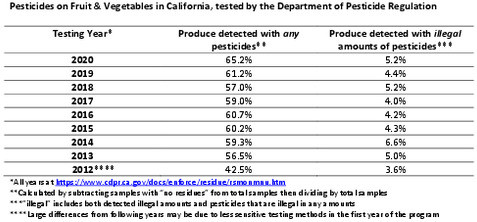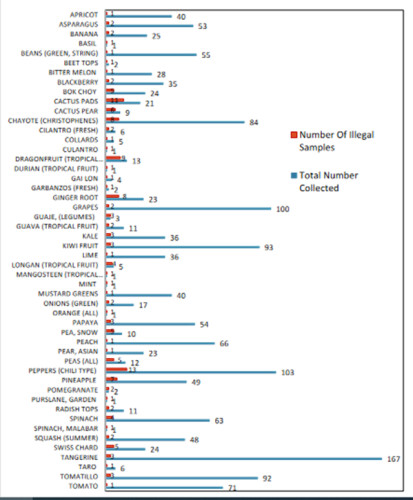From the Open-Publishing Calendar
From the Open-Publishing Newswire
Indybay Feature
Pesticide residues on produce highest ever
Pesticide residues were found on more than 65% of produce in California, according to the latest annual report issued by the California Department of Pesticide Regulation (DPR) last week. That figure is the highest ever recorded by the current California Pesticide Residue Monitoring Program that began in 2012. Illegal levels of pesticides on produce in California also rose -- to a rate of more than 1 in 20 pieces sampled. The rate of illegal samples, 5.2% of the 2,892 fruit and vegetables in 2020, is the third highest recorded.
State also finds illegal levels at 3rd highest since testing began in 2012
Sacramento: Pesticide residues were found on more than 65% of produce in California, according to the latest annual report issued by the California Department of Pesticide Regulation (DPR) last week. That figure is the highest ever recorded by the current California Pesticide Residue Monitoring Program that began in 2012.
DPR’s latest pesticide residue findings are based on data collected in 2020 from 2,892 produce samples collected at nearly 500 locations. The State found pesticide residues on 1,884 of the samples or 65.1%. That figure exceeds the previous high set in 2019 of 61.2% of produce samples with any pesticide residues.
“DPR’s study indicates that Californians are eating more fruits and vegetables with pesticides on them, not less. We’re heading in the wrong direction,” said Angel Garcia, Co-Director of Lindsay-based Californians for Pesticide Reform.
"Poison on your plate" every week
Illegal levels of pesticides on produce in California also rose -- to a rate of more than 1 in 20 pieces sampled. The rate of illegal samples, 5.2% of the 2,892 fruit and vegetables in 2020, is the third highest recorded (2014, 6.6%; 2018, 5.24%--See table above) by DPR. Many pesticides are hazardous to human health, some are classified as carcinogens, as well as reproductive and developmental toxicants, including those harmful to the brain and nervous system.
Illegal levels – those that exceed pesticide residue tolerances set by the U.S. Environmental Protection Agency (U.S. EPA) – were found in 149 of the 2,892 produce samples from 500 California businesses in 2020, including “wholesale and retail outlets, terminal markets, distribution centers, and roadside and farmers markets.”
The annual study is part of the California Pesticide Residue Monitoring Program, which “sample[s] a wide range of fruits and vegetables collected at sites where produce is sold, packed, or distributed.” DPR reports that the “sampling is not designed to be statistically representative of the overall rate of residue levels” but rather selected by factors including:
“Produce highly consumed by infants and children.
Produce treated with pesticides listed under Proposition 65 as carcinogens or
reproductive toxins.
Produce reflective of consumption patterns among different ethnic and socioeconomic groups.
Produce which has a history of detected illegal pesticide residues.
Produce originating from countries with a history of detected illegal pesticide residues.”
While DPR’s press release claims “New State Report Finds Vast Majority of Fruits and Vegetables Sampled in California Meet Pesticide Safety Standards,” some Californians are not reassured, given 5% of produce with illegal pesticides would mean many would consume illegal pesticide residue as often as once a week.
“Do the math: 5% is 1 in 20. If you’re eating 20 helpings of fruits and vegetables a week, on average, you’ve got illegal levels of pesticides on your food once a week. You’ve got poison on your plate more than 50 times a year,” notes Bobbie Joe Garcia, Safe Ag Safe Schools member in Greenfield.
In the Central Valley, Byanka Santoyo of the Center on Race, Poverty, and the Environment (CRPE), is concerned about challenges shopping for healthy food for her family, “What’s a parent to do, if we have to worry about illegal pesticide residues on every couple of dozen pieces of fruit at the grocery store? I guess we need to find the organic section.”
Indeed, the DPR report found illegal pesticide residues on a far lower 1.7% (3 of 173 samples) of organic produce.
###
Californians for Pesticide Reform is a diverse, statewide coalition of 200+ member groups working to strengthen pesticide policies in California to protect public health and the environment. Member groups include public and children's health advocates, clean air and water groups, health practitioners, environmental justice groups, labor, education, farmers and sustainable agriculture advocates from across the state.
Sacramento: Pesticide residues were found on more than 65% of produce in California, according to the latest annual report issued by the California Department of Pesticide Regulation (DPR) last week. That figure is the highest ever recorded by the current California Pesticide Residue Monitoring Program that began in 2012.
DPR’s latest pesticide residue findings are based on data collected in 2020 from 2,892 produce samples collected at nearly 500 locations. The State found pesticide residues on 1,884 of the samples or 65.1%. That figure exceeds the previous high set in 2019 of 61.2% of produce samples with any pesticide residues.
“DPR’s study indicates that Californians are eating more fruits and vegetables with pesticides on them, not less. We’re heading in the wrong direction,” said Angel Garcia, Co-Director of Lindsay-based Californians for Pesticide Reform.
"Poison on your plate" every week
Illegal levels of pesticides on produce in California also rose -- to a rate of more than 1 in 20 pieces sampled. The rate of illegal samples, 5.2% of the 2,892 fruit and vegetables in 2020, is the third highest recorded (2014, 6.6%; 2018, 5.24%--See table above) by DPR. Many pesticides are hazardous to human health, some are classified as carcinogens, as well as reproductive and developmental toxicants, including those harmful to the brain and nervous system.
Illegal levels – those that exceed pesticide residue tolerances set by the U.S. Environmental Protection Agency (U.S. EPA) – were found in 149 of the 2,892 produce samples from 500 California businesses in 2020, including “wholesale and retail outlets, terminal markets, distribution centers, and roadside and farmers markets.”
The annual study is part of the California Pesticide Residue Monitoring Program, which “sample[s] a wide range of fruits and vegetables collected at sites where produce is sold, packed, or distributed.” DPR reports that the “sampling is not designed to be statistically representative of the overall rate of residue levels” but rather selected by factors including:
“Produce highly consumed by infants and children.
Produce treated with pesticides listed under Proposition 65 as carcinogens or
reproductive toxins.
Produce reflective of consumption patterns among different ethnic and socioeconomic groups.
Produce which has a history of detected illegal pesticide residues.
Produce originating from countries with a history of detected illegal pesticide residues.”
While DPR’s press release claims “New State Report Finds Vast Majority of Fruits and Vegetables Sampled in California Meet Pesticide Safety Standards,” some Californians are not reassured, given 5% of produce with illegal pesticides would mean many would consume illegal pesticide residue as often as once a week.
“Do the math: 5% is 1 in 20. If you’re eating 20 helpings of fruits and vegetables a week, on average, you’ve got illegal levels of pesticides on your food once a week. You’ve got poison on your plate more than 50 times a year,” notes Bobbie Joe Garcia, Safe Ag Safe Schools member in Greenfield.
In the Central Valley, Byanka Santoyo of the Center on Race, Poverty, and the Environment (CRPE), is concerned about challenges shopping for healthy food for her family, “What’s a parent to do, if we have to worry about illegal pesticide residues on every couple of dozen pieces of fruit at the grocery store? I guess we need to find the organic section.”
Indeed, the DPR report found illegal pesticide residues on a far lower 1.7% (3 of 173 samples) of organic produce.
###
Californians for Pesticide Reform is a diverse, statewide coalition of 200+ member groups working to strengthen pesticide policies in California to protect public health and the environment. Member groups include public and children's health advocates, clean air and water groups, health practitioners, environmental justice groups, labor, education, farmers and sustainable agriculture advocates from across the state.
For more information:
http://www.pesticidereform.org
Add Your Comments
Latest Comments
Listed below are the latest comments about this post.
These comments are submitted anonymously by website visitors.
TITLE
AUTHOR
DATE
If they're breaking the law, are they (barely) punished?
Thu, Oct 13, 2022 8:33AM
We are 100% volunteer and depend on your participation to sustain our efforts!
Get Involved
If you'd like to help with maintaining or developing the website, contact us.
Publish
Publish your stories and upcoming events on Indybay.
Topics
More
Search Indybay's Archives
Advanced Search
►
▼
IMC Network




